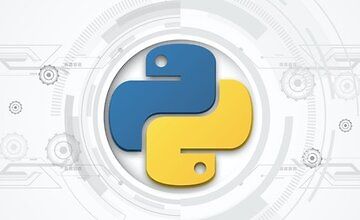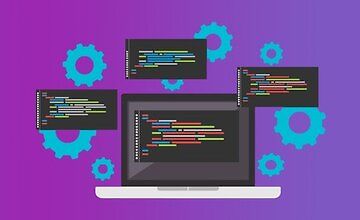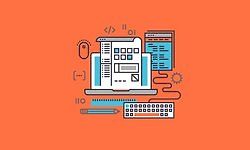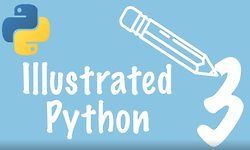-
Урок 1.
00:19:30
What is Python and Father of Python
-
Урок 2.
00:26:15
Easiness of Python when compared with Other Languages
-
Урок 3.
00:08:01
Why the name 'Python'
-
Урок 4.
00:11:09
Python as All Rounder
-
Урок 5.
00:07:07
Where we can use Python
-
Урок 6.
00:13:13
Features of Python: Part-1
-
Урок 7.
00:20:26
Features of Python: Part-2
-
Урок 8.
00:14:03
Features of Python: Part-3
-
Урок 9.
00:13:11
Features of Python: Part-4
-
Урок 10.
00:07:12
Features of Python Summary
-
Урок 11.
00:18:07
Limitations and Flavors of Python
-
Урок 12.
00:13:53
Python Versions
-
Урок 13.
00:21:22
Python Installation
-
Урок 14.
00:17:58
How to Write and Run python code on IDLE
-
Урок 15.
00:05:13
How to Write and Run python code by using NotePad
-
Урок 16.
00:16:07
Install Editplus and Run first Python Program
-
Урок 17.
00:22:22
Python Identifiers
-
Урок 18.
00:13:31
Python Reserved Words
-
Урок 19.
00:15:02
Data Types Introduction
-
Урок 20.
00:22:18
Data Types: int data type
-
Урок 21.
00:08:44
Data Types: Base Conversion Functions
-
Урок 22.
00:12:25
Data Types: float data type
-
Урок 23.
00:13:27
Data Types: complex data type
-
Урок 24.
00:08:09
Data Types: bool data type
-
Урок 25.
00:20:08
Data Types: str data type representations by using single,double and triple quot
-
Урок 26.
00:07:15
Data Types: str data type - positive and negative index
-
Урок 27.
00:16:31
Data Types: str data type - Slice Operator
-
Урок 28.
00:12:44
Data Types: str data type - Slice Operator Applications
-
Урок 29.
00:13:05
Data Types: + and * operators for str data type
-
Урок 30.
00:13:33
Type Casting: introduction and int() function
-
Урок 31.
00:22:36
Type Casting: float() and complex() functions
-
Урок 32.
00:12:25
Type Casting: bool() and str() functions
-
Урок 33.
00:08:49
Type Casting: Summary
-
Урок 34.
00:14:44
Fundamental Data Types vs Immutability : Meaning Of Immutability
-
Урок 35.
00:20:46
Fundamental Data Types vs Immutability : Need Of Immutability
-
Урок 36.
00:20:22
Immutability vs Mutability
-
Урок 37.
00:24:35
Python Data Types: List data type
-
Урок 38.
00:21:55
Python Data Types: Tuple data type
-
Урок 39.
00:21:07
Python Data Types: Set data type
-
Урок 40.
00:10:42
Python Data Types: FrozenSet
-
Урок 41.
00:16:41
Python Data Types: Dict
-
Урок 42.
00:24:18
Python Data Types: range
-
Урок 43.
00:16:52
Python Data Types: bytes and bytearray
-
Урок 44.
00:19:49
Python Data Types Summary
-
Урок 45.
00:12:35
None Data Type
-
Урок 46.
00:17:46
Escape Characters,Comments and Constants
-
Урок 47.
00:05:21
Python Operators Introduction
-
Урок 48.
00:20:39
Arithmetic Operators Part-1
-
Урок 49.
00:14:36
Arithmetic Operators Part-2
-
Урок 50.
00:15:08
Arithmetic Operators Part-3
-
Урок 51.
00:15:29
Relational Operators Part-1
-
Урок 52.
00:11:03
Relational Operators Part-2
-
Урок 53.
00:15:44
Equality Operators
-
Урок 54.
00:13:02
Logical Operators For Boolean Types
-
Урок 55.
00:21:33
Logical Operators For Non-Boolean Types
-
Урок 56.
00:14:19
Bitwise Operators: &,|,^
-
Урок 57.
00:15:22
Bitwise Complement Operator(~) Part-1
-
Урок 58.
00:11:23
Bitwise Complement Operator(~) Part-2
-
Урок 59.
00:20:28
Shift Operators:<< and >>
-
Урок 60.
00:13:57
Assignment Operator
-
Урок 61.
00:13:16
Ternary Operator Part-1
-
Урок 62.
00:24:29
Ternary Operator Part-2
-
Урок 63.
00:19:46
Special Operators:Identity & Membership Operators
-
Урок 64.
00:18:05
Operator Precedence
-
Урок 65.
00:14:06
Basic Idea About Python Module
-
Урок 66.
00:12:38
Various Possible Ways to Import a Module
-
Урок 67.
00:25:21
Important Functions and Variables of math Module
-
Урок 68.
00:14:49
Agenda & Difference between raw_input() and input() functions
-
Урок 69.
00:09:46
Demo Program-1 to Read input data from the keyboard
-
Урок 70.
00:15:50
Demo Program-2 to read input data from the keyboard
-
Урок 71.
00:26:57
Reading Multiple Values from the keyboard in a single line
-
Урок 72.
00:07:49
eval() function
-
Урок 73.
00:16:38
Command Line Arguments Part-1
-
Урок 74.
00:21:08
Command Line Arguments Part-2
-
Урок 75.
00:12:37
Important Conclusions about Command Line Arguments
-
Урок 76.
00:16:05
Output Statements : print() function and sep attribute
-
Урок 77.
00:17:36
Output Statements : end attribute
-
Урок 78.
00:21:43
print(object) and with replacement operator
-
Урок 79.
00:16:59
print() with formatted string
-
Урок 80.
00:18:06
Introduction and Indentation
-
Урок 81.
00:23:38
if-elif-else statement and applications
-
Урок 82.
00:20:49
Finding Smallest and Biggest Number by using if-elif-else Statement
-
Урок 83.
00:25:01
Digits to Words Conversion Programs
-
Урок 84.
00:13:56
Iterative Statements: for loop
-
Урок 85.
00:17:29
Applications by using for loop
-
Урок 86.
00:19:43
While Loop and Applications
-
Урок 87.
00:15:43
Infinite Loops and Nested Loops
-
Урок 88.
00:06:11
To print given number of *s in a row
-
Урок 89.
00:05:52
To print square pattern with * symbols
-
Урок 90.
00:05:38
To print square pattern with provided fixed digit in every row
-
Урок 91.
00:06:16
To print square pattern with alphabet symbols
-
Урок 92.
00:07:50
To print Right Angle Triangle pattern with * symbols
-
Урок 93.
00:06:13
To print Inverted Right Angle Triangle pattern with * symbols
-
Урок 94.
00:12:36
To print Pyramid pattern with * symbols
-
Урок 95.
00:08:25
To print Inverted Pyramid Pattern with * symbols
-
Урок 96.
00:14:58
To print Diamond Pattern with * symbols
-
Урок 97.
00:17:26
Transfer Statements: break statement
-
Урок 98.
00:21:46
Transfer Statements: continue statement
-
Урок 99.
00:11:53
Transfer Statements: break and continue in nested loops
-
Урок 100.
00:19:14
Loops with else block
-
Урок 101.
00:23:51
pass statement
-
Урок 102.
00:16:33
del statement
-
Урок 103.
00:07:07
Prime Numbers Introduction
-
Урок 104.
00:14:50
Program to check whether the given number is prime number or not?
-
Урок 105.
00:09:55
generate prime numbers which are less than or equal the given number
-
Урок 106.
00:09:00
Program to generate first n prime numbers?
-
Урок 107.
00:21:59
Importance of String and Ways of Declaring String
-
Урок 108.
00:15:59
How to access characters of String and application
-
Урок 109.
00:18:58
Slice Operator Introduction
-
Урок 110.
00:15:41
Slice Operator Rules
-
Урок 111.
00:30:55
Slice Operator Case Study
-
Урок 112.
00:22:52
Mathmatical, Membership and Comparison Operators for Strings
-
Урок 113.
00:19:41
Methods: strip(),lstrip(),rstrip() to remove spaces present in the given String
-
Урок 114.
00:14:21
String Methods: find() and rfind() to find substrings
-
Урок 115.
00:17:45
String Methods: index() and rindex() to find substrings
-
Урок 116.
00:08:50
String Methods: count() to find the number of occurrences of substring
-
Урок 117.
00:29:21
Application to print index of all occurrences of the given substring
-
Урок 118.
00:18:15
Methods: replace() to perform replacement of one string with another string
-
Урок 119.
00:13:44
String Methods: split() and join() for Splitting and Joining of Strings
-
Урок 120.
00:18:32
Changing case of characters of the string and Application-1
-
Урок 121.
00:14:43
Changing case of characters of the string: Application-2,3
-
Урок 122.
00:06:01
Checking starting and ending part of the string
-
Урок 123.
00:19:00
Checking Type of characters present in the given String
-
Урок 124.
00:08:29
String Methods Summary
-
Урок 125.
00:10:15
Write a Program To REVERSE content of the given String by using slice operator
-
Урок 126.
00:06:32
Program To REVERSE content of the given String by using reversed() functtion
-
Урок 127.
00:06:49
Write a Program To REVERSE content of the given String by using while loop
-
Урок 128.
00:11:20
Write a Program To REVERSE order of words present in the given string
-
Урок 129.
00:12:48
Write a Program To REVERSE internal content of each word
-
Урок 130.
00:14:55
Program To REVERSE internal content of every 2nd word present in given string
-
Урок 131.
00:15:22
Program:Print characters present at even & odd index separately for given string
-
Урок 132.
00:21:07
Program to merge characters of 2 strings by taking characters alternatively
-
Урок 133.
00:14:14
Program:Sort characters of the string, first alphabet symbols followed by digits
-
Урок 134.
00:12:19
Program for the requirement,input a4b3c2 and expected output aaaabbbcc
-
Урок 135.
00:10:06
Program for the requirement,input a3z2b4 and expected output aaabbbbzz
-
Урок 136.
00:19:59
Program for the requirement,input aaaabbbccz and expected output 4a3b2c1z
-
Урок 137.
00:17:34
Program for the requirement,input a4k3b2 and expected output aeknbd
-
Урок 138.
00:12:16
Program to remove duplicate characters from the given input String
-
Урок 139.
00:15:15
Find no of occurrences of each character present in given string with count( )
-
Урок 140.
00:20:08
Important Conclusions about dictionary
-
Урок 141.
00:09:21
No of occurrences of each character present in given string without count()
-
Урок 142.
00:08:47
Program for the requirement,input: ABAABBCA and expected output: 4A3B1C
-
Урок 143.
00:07:17
Program for the requirement,input: ABAABBCA and expected output: A4B3C1
-
Урок 144.
00:12:50
Program to find the number of occurrences of each vowel present in given string
-
Урок 145.
00:09:50
Program to check whether the given two strings are anagrams or not?
-
Урок 146.
00:05:37
Program to check whether the given string is palindrome or not?
-
Урок 147.
00:13:24
To generate words from given input strings by taking characters alternatively
-
Урок 148.
00:13:59
List Properties
-
Урок 149.
00:12:26
Creation of List Object
-
Урок 150.
00:18:18
Accessing Elements of List By using index and Slice operator
-
Урок 151.
00:11:45
Traversing Elements of the List and Applications
-
Урок 152.
00:14:04
Mathematical Operators for List
-
Урок 153.
00:20:00
Equality, Relational and Membership Operators for List
-
Урок 154.
00:17:55
Important Methods and Functions for List:len(),count() and index()
-
Урок 155.
00:15:51
Important Methods and Functions for List:append() and insert()
-
Урок 156.
00:12:50
Important Methods and Functions for List:extend()
-
Урок 157.
00:15:59
Important Methods and Functions for List:remove
-
Урок 158.
00:15:29
Important Methods and Functions for List:pop() and clear()
-
Урок 159.
00:12:27
Ordering Elements of List:reverse() and reversed()
-
Урок 160.
00:17:56
Ordering Elements of List:sort() and sorted()
-
Урок 161.
00:14:03
Aliasing and Cloning Of List Objects
-
Урок 162.
00:13:24
Nested Lists
-
Урок 163.
00:18:58
List Comprehension and Applications Part-1
-
Урок 164.
00:19:17
List Comprehension and Applications Part-2
-
Урок 165.
00:12:00
Program to find unique vowels present in the given word
-
Урок 166.
00:19:18
Tuple Properties
-
Урок 167.
00:09:03
Single Valued Tuple
-
Урок 168.
00:10:48
Creation of Tuple Object
-
Урок 169.
00:08:34
Accessing Elements of Tuple By using index and Slice operator
-
Урок 170.
00:11:11
Mathematical Operators for Tuple
-
Урок 171.
00:11:58
Equality, Relational and Membership Operators for Tuple
-
Урок 172.
00:07:48
Important Methods and Functions for Tuple:len(),count() and index()
-
Урок 173.
00:17:17
Reversing and Sorting Elements of Tuple
-
Урок 174.
00:12:05
Tuple Packing and Unpacking
-
Урок 175.
00:06:24
Tuple Comprehension
-
Урок 176.
00:28:22
Differences between List and Tuple: Extra Theory
-
Урок 177.
00:11:39
Differences between List and Tuple: Summary
-
Урок 178.
00:06:17
Program to take Tuple of Numbers from the keyboard and print sum,average
-
Урок 179.
00:14:59
Set Properties
-
Урок 180.
00:10:25
Creation of Set Object
-
Урок 181.
00:09:33
Mathematical,Equality, Relational and Membership Operators for Set
-
Урок 182.
00:18:20
Important Methods and Functions for Set:len(),add() and update()
-
Урок 183.
00:12:30
Important Methods and Functions for Set:remove(),discard(),pop() and clear()
-
Урок 184.
00:14:05
Operators:union(),intersection(),difference() and symmetric_difference()
-
Урок 185.
00:12:07
Aliasing,Cloning and Comprehension of Set
-
Урок 186.
00:15:33
Practice Programs for Set
-
Урок 187.
00:14:54
Dictionary Properties
-
Урок 188.
00:15:03
Creation of Dictionary Object
-
Урок 189.
00:21:04
How to access,add,update and delete data from the dictionary
-
Урок 190.
00:12:14
WAP to enter name and marks into dictionary and display information on the scree
-
Урок 191.
00:10:49
Mathematical,Equality, Relational and Membership Operators for Dict
-
Урок 192.
00:14:52
Important Methods and Functions for Dict:len(),get() and update()
-
Урок 193.
00:14:21
Important Methods and Functions for Dict:keys(),values(),items()
-
Урок 194.
00:13:29
Programs to get value based on key and to get key based on value
-
Урок 195.
00:17:12
Important Methods and Functions for Dict:pop(),popitem(),clear()
-
Урок 196.
00:12:15
Important Methods and Functions for Dict:setdefault() and copy()
-
Урок 197.
00:08:00
Important Methods and Functions for Dict: Summary
-
Урок 198.
00:08:14
Program to take dictionary from the keyboard and print sum of values
-
Урок 199.
00:15:01
Program to find number of occurrences of each letter present in the given string
-
Урок 200.
00:08:54
Program to find number of occurrences of each vowel present in the given string
-
Урок 201.
00:24:00
Student Management Application By using dict
-
Урок 202.
00:10:29
Dictionary Comprehension
-
Урок 203.
00:21:47
Merging of Collections
-
Урок 204.
00:19:54
Nested Collections Introduction and Examples
-
Урок 205.
00:22:54
Implementation of supermarket by using dict
-
Урок 206.
00:07:14
List inside Set and Dictionary
-
Урок 207.
00:14:55
Need of Functions and Advantages
-
Урок 208.
00:11:46
Types of Functions and Syntax to define User Define Functions
-
Урок 209.
00:11:25
Function Parameters and Demo Programs
-
Урок 210.
00:20:26
Return Statement
-
Урок 211.
00:11:22
Returning Multiple Values from a function
-
Урок 212.
00:10:30
Types of Arguments: Positional Arguments
-
Урок 213.
00:13:38
Types of Arguments: Keyword Arguments
-
Урок 214.
00:14:41
Types of Arguments: Default Arguments
-
Урок 215.
00:18:02
Types of Arguments: Variable Length Arguments
-
Урок 216.
00:13:54
Important Conclusions about Variable Length Arguments
-
Урок 217.
00:14:34
Differences between *args and **kwargs?
-
Урок 218.
00:16:25
Types of Arguments: Case Study
-
Урок 219.
00:08:00
Types of Variables: Global and Local
-
Урок 220.
00:15:12
Need of global keyword
-
Урок 221.
00:13:06
Important Conclusions about global keyword
-
Урок 222.
00:14:08
Recursive Functions Introduction and Demo Programs
-
Урок 223.
00:13:58
Internal Tracing of Recursive Function Execution
-
Урок 224.
00:09:32
Maximum Recursion Depth In Python
-
Урок 225.
00:12:56
Anonymous Functions/Lambda Functions
-
Урок 226.
00:11:28
Lambda Functions Demo Programs
-
Урок 227.
00:04:00
Function as argument to another function
-
Урок 228.
00:25:17
Shorter Code By using filter() function
-
Урок 229.
00:18:07
filter() Function Demo Programs
-
Урок 230.
00:19:43
map() Function Theory and Demo Programs
-
Урок 231.
00:13:58
reduce() Function and Demo Programs
-
Урок 232.
00:22:12
How to write and use Module and Its Advantages
-
Урок 233.
00:15:31
Module Aliasing, from...import
-
Урок 234.
00:11:00
Member Aliasing and Various Possibilities of Import Statement
-
Урок 235.
00:13:18
Module Naming Conflicts
-
Урок 236.
00:20:11
Module Reloading
-
Урок 237.
00:15:48
Difference between dir() and help() functions
-
Урок 238.
00:16:28
Extra Members Added By Python Interpreter For Every Module
-
Урок 239.
00:15:02
Special Variable: __name__ Part-1
-
Урок 240.
00:12:39
Special Variable: __name__ Part-2
-
Урок 241.
00:15:28
Working with math module
-
Урок 242.
00:12:38
Python Certification Practice Questions On math module
-
Урок 243.
00:12:42
Working with random Module: random() and uniform() functions
-
Урок 244.
00:14:17
Working with random Module: randint() and randrange() functions
-
Урок 245.
00:12:23
Working with random Module: choice() function
-
Урок 246.
00:20:49
Programs to generate Random OTP and Passwords
-
Урок 247.
00:15:35
Program To Generate Fake Employee Data For Database Testing:Part-1
-
Урок 248.
00:21:26
Program To Generate Fake Employee Data For Database Testing:Part-2
-
Урок 249.
00:08:53
Basic Review of Functions and Modules
-
Урок 250.
00:22:41
Introduction to Python Packages
-
Урок 251.
00:09:07
Advantages of Packages
-
Урок 252.
00:28:08
Demo Programs to create and use packages
-
Урок 253.
00:11:35
Importance of __init__.py file
-
Урок 254.
00:15:41
Need of Installing a Python Package
-
Урок 255.
00:23:20
How to Install a Python Package
-
Урок 256.
00:27:02
Class, Object and Reference Variable In Simple Way
-
Урок 257.
00:13:31
How to define a class ?
-
Урок 258.
00:25:01
Demo programs to define and use a class
-
Урок 259.
00:21:42
The Complete Postmortem of self variable Part-1
-
Урок 260.
00:14:21
The Complete Postmortem of self variable Part-2
-
Урок 261.
00:15:25
The Complete Story of Python Constructors Part-1
-
Урок 262.
00:19:25
The Complete Story of Python Constructors Part-2
-
Урок 263.
00:29:42
Mini Application to explain Object Oriented Programming
-
Урок 264.
00:11:13
Differences between Method and Constructor
-
Урок 265.
00:19:12
Basic Idea About Types of Variables - Instance, Static and Local
-
Урок 266.
00:20:52
Basic Idea About Types of Methods - Instance, Class and Static
-
Урок 267.
00:25:24
Various places to declare Instance Variables
-
Урок 268.
00:20:13
How to access, delete and update Instance Variables
-
Урок 269.
00:22:57
Various Places to declare Static Variables
-
Урок 270.
00:11:34
How to access Static Variables
-
Урок 271.
00:11:44
Where we can modify value of Static Variables
-
Урок 272.
00:16:38
Example Programs Set-1 about instance and static variables
-
Урок 273.
00:13:11
Example Programs Set-2 about instance and static variables
-
Урок 274.
00:15:29
How to delete static variables?
-
Урок 275.
00:09:07
Instance Variable vs Static Variable
-
Урок 276.
00:13:43
Local Variables
-
Урок 277.
00:29:33
Mini Bank Application
-
Урок 278.
00:20:21
Instance Methods Introduction and Demo Program
-
Урок 279.
00:18:05
Setter and Getter Methods
-
Урок 280.
00:18:46
Class Methods Introduction and Demo Programs
-
Урок 281.
00:06:30
Differences between Instance Method and Class Method
-
Урок 282.
00:09:06
Static Methods Introduction and Demo Program
-
Урок 283.
00:21:24
Instance Method vs Class Method vs Static Method
-
Урок 284.
00:09:52
Accessing Members of one class inside another class
-
Урок 285.
00:28:18
Inner classes Introduction and Demo Program
-
Урок 286.
00:12:58
Nesting of Inner Classes Demo Program-1
-
Урок 287.
00:22:18
Nesting of Inner Classes Demo Program-2
-
Урок 288.
00:19:09
Inner Classes Demo Program-3
-
Урок 289.
00:13:02
Nested Methods
-
Урок 290.
00:16:40
Garbage Collection Introduction
-
Урок 291.
00:08:24
How to enable and disable Garbage Collector
-
Урок 292.
00:23:12
Destructor Introduction and Demo Program-1
-
Урок 293.
00:16:55
Destructor Demo Programs - 2,3
-
Урок 294.
00:20:30
The 3 Important Interview Questions
-
Урок 295.
00:19:50
HAS-A Relationship Introduction and Demo Program-1
-
Урок 296.
00:10:31
HAS-A Relationship Demo Program-2
-
Урок 297.
00:17:32
HAS-A Relationship Demo Program-3
-
Урок 298.
00:23:10
IS-A Relationship Introduction and Demo Programs
-
Урок 299.
00:13:31
Developing Employee and Person classes with Inheritance
-
Урок 300.
00:12:44
Inheritance Importance
-
Урок 301.
00:20:02
IS-A vs HAS-A Relationships
-
Урок 302.
00:22:48
Composition vs Aggregation
-
Урок 303.
00:22:41
Types of Inheritance: Single, Multi-Level and Hierarchical
-
Урок 304.
00:19:29
Types of Inheritance: Multiple Inheritance
-
Урок 305.
00:12:40
Types of Inheritance: Hybrid and Cyclic Inheritances
-
Урок 306.
00:19:02
Method Resolution Order (MRO) Algorithm Theory Part-1
-
Урок 307.
00:28:45
Method Resolution Order (MRO) Algorithm Theory Part-2
-
Урок 308.
00:24:43
Demo Program-1 For Method Resolution Order (MRO) Algorithm
-
Урок 309.
00:15:12
Demo Program-2 For Method Resolution Order (MRO) Algorithm
-
Урок 310.
00:11:09
The complete story of super() function- Theory
-
Урок 311.
00:19:43
Demo programs to describe use of super() function
-
Урок 312.
00:12:30
How to call method of a particular super class
-
Урок 313.
00:09:49
super() vs Parent class Instance Variables
-
Урок 314.
00:20:20
Various Important Conclusions of super() function
-
Урок 315.
00:17:26
Polymorphism Basic Introduction
-
Урок 316.
00:24:03
Operator Overloading Introduction and Demo Program
-
Урок 317.
00:20:31
Operator and Corresponding Magic Methods, Demo program
-
Урок 318.
00:16:24
Overloading of multiplication operator for Employee Objects
-
Урок 319.
00:13:29
Importance of __str__() method
-
Урок 320.
00:27:31
Overloading of + operator for Nesting Requirements
-
Урок 321.
00:16:01
Method Overloading Introduction
-
Урок 322.
00:10:58
Why Python won't support Method Overloading
-
Урок 323.
00:24:24
How to define a method with variable number of arguments
-
Урок 324.
00:14:31
Constructor Overloading
-
Урок 325.
00:20:28
Method Overriding and Constructor Overriding
-
Урок 326.
00:18:05
Overriding Demo Program
-
Урок 327.
00:06:20
Polymorphism summary
-
Урок 328.
00:26:36
Abstract Method and Abstract Class
-
Урок 329.
00:24:12
Important Conclusions of Abstract Method & Abstract Class
-
Урок 330.
00:18:20
Interfaces In Python
-
Урок 331.
00:11:28
Interface vs Abstract Class vs Concrete Class
-
Урок 332.
00:07:57
Public Members
-
Урок 333.
00:16:22
Private Members
-
Урок 334.
00:09:05
Protected Members
-
Урок 335.
00:16:03
Data Hiding
-
Урок 336.
00:20:15
Abstraction
-
Урок 337.
00:23:50
Encapsulation
-
Урок 338.
00:03:21
The Three Pillars of OOPs
-
Урок 339.
00:19:01
Syntax Error vs Runtime Error
-
Урок 340.
00:23:56
The 3 Most Important Questions about Exception Handling
-
Урок 341.
00:16:27
Default Exception Handling and Exception Hierarchy
-
Урок 342.
00:13:33
Customized Exception Handling by using try-except
-
Урок 343.
00:15:54
Control flow in try-except
-
Урок 344.
00:15:31
How to print Exception Information to the console?
-
Урок 345.
00:18:35
try with multiple except blocks?
-
Урок 346.
00:08:10
Single except block that can handle multiple different exceptions
-
Урок 347.
00:23:33
Default Except Block & Various except block syntaxes
-
Урок 348.
00:18:33
finally block purpose and Specialty
-
Урок 349.
00:15:52
finally block vs os._exit(0)
-
Урок 350.
00:04:53
Important Interview Question: difference between finally block and destructor
-
Урок 351.
00:11:06
Control Flow in try-except-finally
-
Урок 352.
00:28:12
Nested try-except-finally theory and demo program
-
Урок 353.
00:32:56
Control Flow in Nested try-except-finally
-
Урок 354.
00:17:39
else block with try-except-finally theory
-
Урок 355.
00:19:05
else block with try-except-finally demo programs
-
Урок 356.
00:32:58
Various possible combinations of try-except-else-finally
-
Урок 357.
00:28:03
Types of Exceptions-Predefined and User Defined
-
Урок 358.
00:21:03
How to define and raise Customized Exceptions & Demo Program
-
Урок 359.
00:19:16
Introduction to Python Logging and Logging Levels
-
Урок 360.
00:21:30
How to implement logging with demo program
-
Урок 361.
00:10:28
How to configure log file for over writing mode and default values ?
-
Урок 362.
00:18:26
How to format log messages ?
-
Урок 363.
00:17:09
How to add time and date to the log messages ?
-
Урок 364.
00:22:32
How to add exception information to the log file and Demo Program
-
Урок 365.
00:24:28
Problems with root logger ?
-
Урок 366.
00:21:24
How to define and use Customized Logger?
-
Урок 367.
00:10:32
Demo Programs set-1 to define and use Custom Logger with File and Console Handle
-
Урок 368.
00:19:43
Demo Programs set-2 to define and use Custom Logger with File and Console Handle
-
Урок 369.
00:12:34
Importance of inspect module
-
Урок 370.
00:18:29
Creation of generic logger and usage
-
Урок 371.
00:13:10
Demo Program for Creation of generic logger and usage
-
Урок 372.
00:07:07
Need of separating logger configurations into a file?
-
Урок 373.
00:22:12
Demo programs for separating logger configurations into a file and dictionary?
-
Урок 374.
00:21:44
Assertions Introduction
-
Урок 375.
00:23:48
Types of Assert Statements-Simple & Augmented Versions
-
Урок 376.
00:15:56
Demo Program to perform debugging by using assertions
-
Урок 377.
00:15:28
Introduction and Types of Files
-
Урок 378.
00:27:11
Opening a File and Various File Modes
-
Урок 379.
00:17:47
Closing a File and Various Properties of File Object
-
Урок 380.
00:25:16
Writing Character data to text files
-
Урок 381.
00:08:06
Program for writing Dynamic Data to Dynamic File
-
Урок 382.
00:15:48
Reading Character data from text files-read(),read(n)
-
Урок 383.
00:23:02
Reading Data Line by Line- readline(),readlines()
-
Урок 384.
00:04:28
Program-reading data from one file & writing to another file
-
Урок 385.
00:11:51
The with Statement
-
Урок 386.
00:15:50
tell() and seek() methods
-
Урок 387.
00:17:04
Demo Programs for tell() and seek() methods
-
Урок 388.
00:11:42
How to check a particular file exists or not?
-
Урок 389.
00:22:00
Print Number of lines,words,characters in file
-
Урок 390.
00:20:43
Writing Data to CSV File by using csv module
-
Урок 391.
00:13:06
Reading Data from CSV File by using csv module
-
Урок 392.
00:21:54
Function Aliasing and Nested Functions
-
Урок 393.
00:20:37
Function as Return Value and Function as Argument
-
Урок 394.
00:26:31
Basic Introduction to Decorators with Demo Program
-
Урок 395.
00:14:04
Demo Program -2 for Decorator Functions
-
Урок 396.
00:23:58
Demo Programs 3 & 4 for Decorator Functions
-
Урок 397.
00:11:10
How to call same function with and without Decorator?
-
Урок 398.
00:25:59
Decorator Chaining and Demo Example Part-1
-
Урок 399.
00:12:26
Decorator Chaining Demo Example Part-2
-
Урок 400.
00:19:25
Decorator Chaining Demo Example Program - 2
-
Урок 401.
00:23:22
Importance of Python Generators
-
Урок 402.
00:18:48
Demo Programs Set-1 For Generators
-
Урок 403.
00:19:48
Demo Programs Set-2 For Generators
-
Урок 404.
00:14:45
Performance Comparison of Collections & Generators
-
Урок 405.
00:13:36
Advantages and Limitations of Generators







Youtube-level BS.